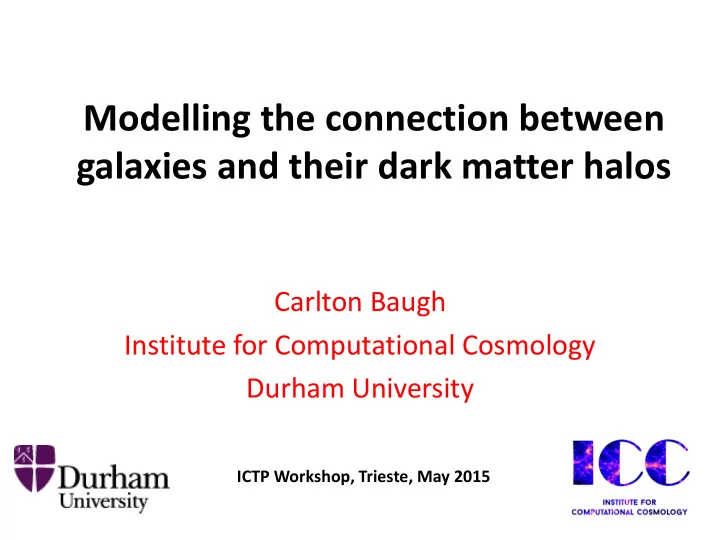

Modelling the connection between galaxies and their dark matter halos Carlton Baugh Institute for Computational Cosmology Durham University ICTP Workshop, Trieste, May 2015
GALAXIES DARK MATTER
The efficiency of galaxy formation SNe Cooling feedback suppression • Galaxy formation very Stellar mass/halo mass inefficient • Globally only a few percent (~5%) of baryons are stars • Different processes set efficiency of galaxy formation in different Guo et al. 2010 (sub)halo mass mass DM halos Attempt to model the physics that shape this relation using gas simulations and semi-analytical models
Gas dynamics simulations: e.g. EAGLE 60kpc 10 Mpc Schaye et al. 2014 See Tom Theun’s talk Furlong et al. 2014 Schaller et al. 2014 Trayford et al 2015…..
What is semi-analytical modelling? A new model of galaxy formation Lacey et al. 2015
Follow baryons in halo merger tree time Solve set of coupled differential equations Baugh 2006, Benson 2010
What is semi-analytical modelling? • Model parameters – too many?
Model parameters Lacey et al. 2015
Model parameters Lacey et al. 2015
What is semi-analytical modelling? • Model parameters • Parameter calibration Lacey et al. 2015
Local galaxy luminosity function Calibrated model Vary strength of SNe feedback Try different parameter values until model reproduces target data Lacey et al. 2015
Luminosity function Tully- Fisher Parameter calibration – multi-property space Lacey et al 2015 Size – luminosity for disks 250 micron counts
What is semi-analytical modelling? • Model parameters • Parameter calibration • Modular – upgrade implementation of physics Lacey et al. 2015
An example of semi-analytics in action: Modelling star formation: old method Parametric forms for the SF law (total cold gas mass/SF timescale) What is ? Cole et al. (2000) Two free-parameters to model the SF activity Lagos et al. 2011
What drives star formation? Atomic hydrogen CO – molecular hydrogen Star formation activity Leroy et al. 2008 The Blitz & Rosolowski law (BR) Leroy et al. (2008), Bigiel et al. (2008)
The mass function of atomic hydrogen • Improved modelling of star formation • Reduced volume of parameter space • New predictions: HI mass function and Lacey et al. 2015 CO LF • Illustrates modular approach of semi- analytics Lagos et al. 2011, 2012
Simulated ALMA images of GALFORM galaxies (see Lagos et al. 2012 GALFORM + UCL_PDR model)
What is semi-analytical modelling? • Model parameters • Parameter calibration • Modular – upgrade implementation of physics • Multi-wavelength/multi-property outputs Lacey et al. 2014
UV luminosity function at high-z z=4 z=3 Lacey et al. 2011
UV luminosity function at high-z z=5 z=6 Lacey et al. 2011
Multi-wavelength maps of dusty star-forming galaxies Cowley et al. 2014
What is semi-analytical modelling? • Model parameters • Parameter calibration • Modular – upgrade implementation of physics • Multi-wavelength outputs • Complementary to gas simulations Lacey et al. 2014
SAMs vs gas simulations Present-day stellar mass function SAMs vs EAGLE GAS SIMs vs EAGLE Schaye et al. 2014
The galaxy – halo connection How robust are the predictions of different semi-analytical models? How well do empirical clustering models (HOD, SHAM) describe SAMS? Contreras et al. 2013, arXiv:1301.3497 Contreras et al. 2014
Comparison of public results N-BODY Millennium – I Independent construction of N-body simulation DM halo merger trees + SEMI-ANALYTICS Different physics implementations: Bower et al. 20006 AGN feedback, SNe feedback, De Lucia & Blaizot 2007 gas cooling in satellites Bertone et al. 2007 Font et al. 2008 Different observations used to set Guo et al. 2011 Model parameters Contreras et al. 2013
How many galaxies? Cumulative number densities for stellar mass, cold gas mass, SFR Stellar mass Cold gas mass SFR Agreement between models reflects choice of calibration data Contreras et al. 2013
How many galaxies in each halo? Galaxies ranked by STELLAR MASS: Decreasing galaxy abundance One galaxy per halo Halo Occupation Distribution: model OUTPUT Contreras et al. 2013
Clustering: stellar mass samples Decreasing galaxy abundance 2-halo terms remarkably similar - robust prediction of bias 1-halo terms different, but same number of satellites: why? Contreras et al. 2013
Small scale clustering differences: Median radius of galaxy pairs in halo Satellites with sub-halo Satellites with no sub-halo Explained by modelling of galaxy mergers Contreras et al. 2013
Contreras et al. 2013
How do galaxy properties change with sub-halo mass? Does the output of SAM look like SHAM?
Star formation Stellar mass Cold gas mass rate Subhalo mass Contreras et al 2014
Which subhalos host galaxies? Samples defined by STELLAR MASS Contrast SAM predictions with simple SHAM Contreras et al 2014
Does SHAM reproduce SAM? Impact on correlation function Galaxies ranked by their STELLAR MASS Compare clustering predicted directly by semi-analytic model with that predicted using a simple SHAM reconstruction Contreras et al. (2014)
Which subhalos host galaxies? Samples defined by COLD GAS MASS Contrast SAM predictions with SHAM Contreras et al 2014
Does SHAM reproduce SAM? Impact on correlation function Galaxies ranked by their STAR FORMATION RATE RED: Indirect: SHAM on stellar mass, use model SFR/stellar mass ratio Empirical reconstructions over predict the semi-analytic clustering Contreras et al. (2014)
Conclusions • Semi-analytical models allow us to test our ideas about galaxy formation: complementary to gas sims • Robust predictions for clustering of galaxies selected by stellar mass • Less robust predictions for abundance and clustering of SFR & cold gas mass selected samples: variation in one-halo term – different numbers of satellites • Generic features predicted in HOD • HOD(M*) looks like standard form • HOD(SFR or cold gas) peaked – different • Some properties close to SHAM assumption e.g. M* • Others very different from SHAM e.g. cold gas mass
GALAXIES DARK MATTER GALFORM – The Movie
Recommend
More recommend